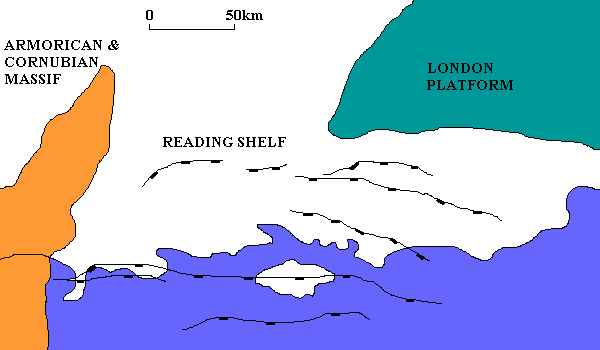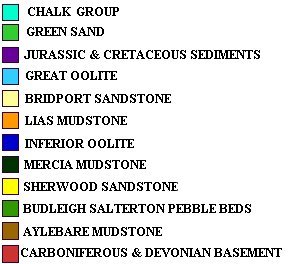Basin Development Stratigraphy
![]()
The Wessex Basin is a series of extensional sub-basins, which are part of a more extensive network. This network developed in the Mesozoic and formed intercratonic basins that covered most of NW Europe. The Wessex basin covers an onshore area of greater than 20,000 km2 and a similar area beneath the English Channel.
The basement rock is Cambrian to Carboniferous which has been deformed by thrust related structures in the late Carboniferous Variscan orogeny (Chadwick, 1986). These are unconformably overlain by the Aylesbare mudstone (post Variscan subsidence) and the Sherwood Sandstone Group. Contact with the Mercia mudstone above varies at different locations being both conformable and unconformable. Sediments within the basin are mostly Permian to Tertiary in age deposited during post Carboniferous subsidence.
Seismic evidence shows that the normal faulting that controlled sedimentation in the basin is a reactivation of Variscan thrust faults.
The Wessex Basin is bounded by the London platform to the north, the Armorican and Cornubian Massif to the West and Southwest and the Central Channel High to the South. The Northwest and Northeast boundaries are not well defined (Underhill & Stoneley, 1998).
Basin development - in four distinct phases. (Stoneley & Selly, 1991)
1- Permo - Triassic. A period of continental desert sedimentation, initially contemporaneous with waning Hercynian igneous activity, and governed both by pre-existing Armorican highlands to the west and southwest, and N/S extension resulting in E/W trending faults.
2- Jurassic - Early Cretaceous. Transition from a dominantly continental environment to open marine conditions. Shallow water marine sedimentation in the Jurassic. Synsedimentary extensional faulting, which trended E/W and in southern Dorset was down-thrown to the south.
3- Late Cretaceous. An episode of further faulting, eastward tilting and erosion in late Neocomian. Marine chalk sedimentation representing a thermal sag phase in the basins development with sediments onlapping underlying faulted sequences resulting in a "steer's head" geometry. Gradual transgressive conditions during the Aptian and the Albian.
4- Tertiary - Recent. Tectonic inversion occurred in the early Tertiary due to South to North compression, reversed movement was initiated along the lines of earlier extensional faulting with the earlier faults being down-thrown to the north.

The Wessex Basin showing dominant E/W faulting. (Lacroix, 1999)
The BSPB consists of limestone pebbles and cobbles, which have been identified as being Devonian and Carboniferous limestone, possibly derived from the Quantock Hills or Mendip Hills area (Strong et al, 1987).
The contact between the BSPB and the Otter sandstone is
marked by a layer of ventifacts, which is overlain by cross-bedded aeolian
sandstones, which pass up into fluvial sandstones.
 |
 |
Subsurface Geology of the Wessex Basin. Modified from Lacroix (1999)
The Budleigh Salterton Pebble Beds have been interpreted as the start of the early phase of Triassic rifting and rapid subsidence.
The Otter Sandstone Formation is a thick sequence, which is Anisian to Ladinian in age consisting of an arkosic sandstone and mudrock. The unit exhibits a series of fining upwards cycles often with erosional conglomerate bases, and is about 150m thick and is overlain by the Mercia mudstone.
The Otter Sandstone Formation lies directly on pre-Triassic sediments in places reflecting the possible erosion of the BSPB prior to the deposition of the Otter Sandstone Formation or the deposition just in the Southampton part of the basin may reflect local alluvial fans that wedge out westwards and pass into penecontemporaneous sandstone facies (Smith, 1991).
The Permo-Triassic red bed siliciclastics are overlain by Jurassic and Cretaceous marine siliciclastics and carbonates.
![]()
 |
Page constructed by M. Wheeler
Copyright © 2000 Mark J Wheeler